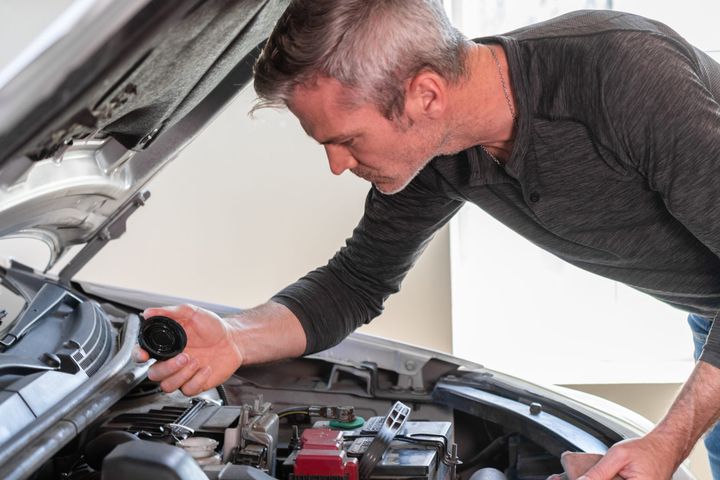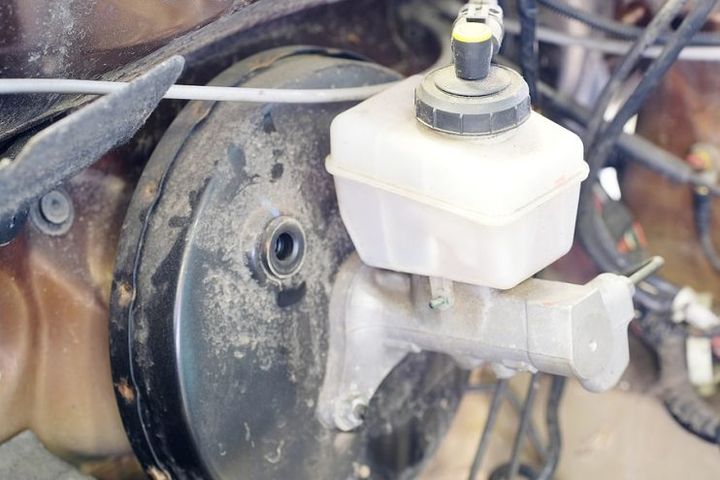


The brake master cylinder is a critical component of a vehicle's braking system, responsible for converting the mechanical force applied to the brake pedal into hydraulic pressure. This hydraulic pressure is then transmitted through the brake lines to the brake calipers or wheel cylinders, causing the brake pads or shoes to press against the rotors or drums, ultimately slowing down or stopping the vehicle.

The brake master cylinder acts as the heart of your vehicle's braking system, converting the force you apply to the brake pedal into hydraulic pressure. This pressure is then transmitted through the brake lines to the calipers or wheel cylinders, ultimately causing the brake pads or shoes to clamp down on the rotors or drums, slowing or stopping your vehicle.
| Cause | Description |
|---|---|
| Leaks | Worn or damaged seals and gaskets can allow brake fluid to leak out, leading to loss of pressure and braking power. |
| Contamination | Debris, moisture, or air entering the master cylinder can contaminate the brake fluid, causing corrosion and improper operation. |
| Internal Wear | Over time, internal components like pistons, seals, and springs can wear out, resulting in reduced efficiency and pressure output. |
| External Damage | Physical damage to the master cylinder body or mounting points can occur due to accidents or corrosion, leading to leaks or improper function. |
One of the most common indicators of a failing brake master cylinder is a spongy or low brake pedal. When you press down on the pedal, it should feel firm and responsive. However, if the pedal feels soft or sinks all the way to the floor without much resistance, it's a clear sign that something is amiss.
This issue typically arises due to one of two reasons:
A leak in the master cylinder, causing a loss of hydraulic pressure
Air entering the system, creating a spongy feel
In either case, it's a serious problem that needs immediate attention, as it can significantly reduce your braking power and increase stopping distances.
Another telltale sign of a bad brake master cylinder is the presence of brake fluid leaks. These leaks can manifest in various ways:
A puddle of fluid under your vehicle
A low brake fluid level in the reservoir
Brake fluid leaks can occur due to worn or damaged seals and gaskets within the master cylinder, allowing the fluid to escape. Not only does this lead to a loss of braking power, but it can also introduce air into the system, exacerbating the spongy pedal issue.
If you notice your vehicle pulling to one side when you apply the brakes, or if the braking feels uneven between the front and rear wheels, it could be an indication of a faulty brake master cylinder.
This symptom often arises when the master cylinder's internal components, such as pistons or seals, become worn or damaged. As a result, the hydraulic pressure distribution to the individual brake circuits may become unbalanced, leading to uneven braking performance.
Modern vehicles are equipped with various warning lights on the dashboard, including those related to the braking system. If you notice a brake warning light illuminated, it could be a sign of a problem with the master cylinder or another component in the braking system.
While the warning light alone may not pinpoint the exact issue, it's a clear indication that something is amiss and requires further investigation by a professional mechanic.
To identify a faulty brake master cylinder, a mechanic will typically perform the following steps:
Check for any visible leaks around the master cylinder, brake lines, or under the vehicle.
Inspect the brake fluid level and condition in the reservoir. Low or contaminated fluid can indicate a problem.
Look for signs of external damage, corrosion, or loose mounting on the master cylinder.
Depress the brake pedal and observe its feel. A soft, spongy, or low pedal can indicate a problem with the master cylinder or air in the system.
Apply the brakes while driving at low speed. If the vehicle pulls to one side or the braking is uneven, it may suggest a master cylinder issue.
Check for any warning lights related to the braking system on the dashboard.
Depending on the specific issue, the repair process may involve:
Drain the brake fluid and remove the master cylinder from the vehicle.
Disassemble the master cylinder and replace any worn or damaged seals, gaskets, and internal components.
Reassemble the master cylinder, ensuring proper lubrication and alignment.
If the master cylinder is severely damaged or worn, it may need to be replaced entirely.
Follow the manufacturer's instructions for proper removal and installation procedures.
Bleed the brake system after installation to remove any air pockets.
| Repair Type | Description |
|---|---|
| Seal/Gasket Replacement | Replace worn or damaged seals, gaskets, and internal components. |
| Complete Replacement | Replace the entire master cylinder if severely damaged or worn. |
Use only the recommended brake fluid type for your vehicle.
Ensure all components are clean and free of debris before reassembly.
Torque all fasteners to the specified values.
Bleed the brake system thoroughly after any repair or replacement.

To prevent future issues with the brake master cylinder:
Follow the manufacturer's recommended maintenance schedule for brake fluid flushes and inspections.
Avoid operating the vehicle with low brake fluid levels or a faulty master cylinder.
Keep the brake system clean and free of contaminants.
Inspect the brake system regularly for any signs of leaks, wear, or damage.
The cost of repairing or replacing a brake master cylinder can vary depending on several factors:
Labor costs: Typically ranging from $100 to $300, depending on the repair complexity and location.
Parts costs: A new OEM (Original Equipment Manufacturer) master cylinder can cost $100 to $400, while aftermarket options may be more affordable.
Additional repairs: If other components like brake lines or calipers need replacement, the overall cost can increase.
On average, expect to pay between $300 and $800 for a complete brake master cylinder replacement, including parts and labor. However, it's always best to consult with a professional mechanic for an accurate estimate based on your specific vehicle and repair needs.
As a mechanic, I cannot stress enough the importance of addressing brake system issues promptly. A faulty brake master cylinder can have severe consequences, and ignoring the warning signs can put you and others at risk.
By being aware of the symptoms we've discussed, such as a spongy brake pedal, fluid leaks, uneven braking, and warning lights, you can take proactive steps to have your vehicle inspected and repaired by a professional.
Remember, your safety on the road should always be the top priority. Don't hesitate to seek the expertise of a qualified mechanic if you suspect any issues with your vehicle's braking system, particularly the brake master cylinder.
The brake master cylinder converts the force applied to the brake pedal into hydraulic pressure that activates the brakes. It is the heart of the vehicle's braking system.
Common causes of brake master cylinder failure include leaks, contamination, internal wear, and external damage.
Signs of a bad brake master cylinder include a spongy or low brake pedal, brake fluid leaks, uneven braking, and illuminated warning lights on the dashboard.
In some cases, a brake master cylinder can be repaired by replacing worn seals, gaskets, or internal components. However, if severely damaged, a complete replacement may be necessary.
It is recommended to have the brake master cylinder inspected as part of regular maintenance, following the manufacturer's recommended schedule.
Driving with a faulty brake master cylinder can lead to a complete loss of braking power, putting you and others at risk of accidents. It should be addressed immediately.
Yes, a brake master cylinder can fail suddenly due to factors like internal component failure or external damage, leading to a sudden loss of braking ability.
While it is possible to replace the brake master cylinder yourself if you have the necessary skills and tools, it is generally recommended to have it done by a professional mechanic to ensure proper installation and bleeding of the brake system.
Always use the recommended brake fluid type specified by the vehicle manufacturer to ensure compatibility and proper brake system operation.
To prevent brake master cylinder issues, follow the recommended maintenance schedule, keep the brake system clean and free of contaminants, and address any signs of leaks or wear promptly.

Sarah isn't your average gearhead. With a double major in Mechanical Engineering and Automotive Technology, she dived straight into the world of car repair. After 15 years of turning wrenches at dealerships and independent shops, Sarah joined MICDOT to share her expertise and passion for making cars run like new. Her in-depth knowledge and knack for explaining complex issues in simple terms make her a valuable asset to our team.



